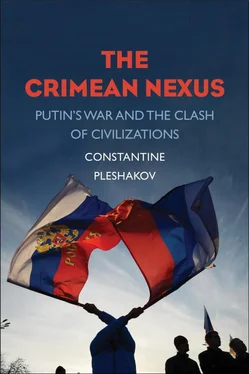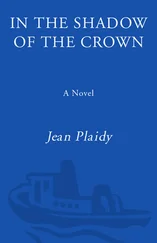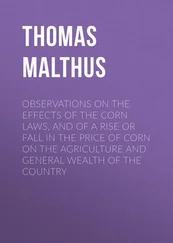Carelessness, infighting, bad judgment, and corruption had prevented Ukraine from forging a strong military. Counting on exactly that, Vladimir Putin launched a covert takeover operation that precluded bloodshed or the conspicuous use of arms. Putin claimed that he ordered the annexation of Crimea only after the ousting of Viktor Yanukovych, in the small hours of February 23, 2014. This may be true, but some preparations for the takeover must have begun earlier. [13] John C. K. Daly, “After Crimea: The Future of the Black Sea Fleet,” The Jamestown Foundation , May 22, 2014; Vladimir Putin’s interview in a documentary, “Crimea: A Way Home,” Gazeta.ru, March 15, 2015, www.gazeta.ru/politics/2015/03/15_a_6600065.shtml (retrieved April 17, 2015).
Three political goals had to be reached before the military operation began. The Russophiles on the peninsula had to be mobilized; the political establishment of Crimean Tatars had to be neutralized; and world opinion had to be probed for sympathy and prepared for the eventuality.
The casus belli for Crimean separatism was the specter of “Ukrainian fascism.” Far-right nationalist groups commanded only marginal support in Ukraine, but their presence in Euromaidan and riots elsewhere suggested a determination and vengefulness lacking in other political forces. The Russophiles in the Crimean government, grassroots activists, and of course Putin’s propaganda machine predicted imminent invasion and massacres by “fascists from Western Ukraine.”
This catastrophic scenario was far-fetched but not baseless. The Ukrainian far-right parties and militias were already spread too thin throughout Ukraine’s core, and there was no way they could seriously threaten Crimea. But, usefully for Putin, they talked a good game. Their bellicose rhetoric, their smug use of Nazi symbols, and their declarations of an all-out war against “Ivans” ( moskaly ) were all real.
All over Ukraine, people died in ambushes, street fighting, and arsons, and although the total casualties probably did not exceed two hundred, rumors increased that number tenfold. In the atmosphere of uncertainty and fear, and with the Ukrainian state collapsing, the idea of seceding from Ukraine and joining Russia was an easy sell to Crimea’s majority.
Neutralizing the Tatar leadership was more difficult. Mustafa Dzhemilev warned that Tatars would not accept a referendum at gunpoint. He could not be swayed even when Putin called him personally. But Crimea’s new class of Tatar entrepreneurs was less resistant to Moscow’s overtures.
The Kremlin asked leaders of the Volga Tatar community to intercede in Crimea, to showcase the benefits of being with Russia. The 2 million Volga Tatars were autonomous within the Russian Federation—the Republic of Tatarstan, centered on its capital, Kazan, a thriving regional metropolis. Predictably, Kazan loyalists failed to persuade Dzhemilev, but their effect on the Crimean Tatar business community was significant. [14] “About the Republic,” Official Tatarstan (Tatarstan.ru), http://tatarstan.ru/eng/about/population.htm (retrieved April 18, 2015).
Russia has 20 million Muslims, more than any other country in Europe, and they make up the country’s second-largest religious group after Orthodox Christians. In a new spirit of interfaith cooptation, Putin declared Islam “a striking element of the Russian cultural code, an inalienable, organic part of Russian history.” Russia’s mainstream Muslim clerics embraced the “harmony and unity” approach. All of that should have at least somewhat alleviated the Crimean Muslims’ concerns. [15] Robert D. Crews, “Moscow and the Mosque: Co-opting Muslims in Putin’s Russia,” Foreign Affairs , March/April 2014.
The Kremlin could not possibly have hoped to achieve as much in the outside world. The “Ukrainian fascists” card was hard to play with foreign audiences. First, the threat posed by the Euromaidan far right was largely latent. Second, after the numerous follies of the 2000s—especially its effort to present a brutal war on Chechnya as a defensive battle against terrorists—Putin’s propaganda apparatus had zero credibility in the West. Third, mainstream Western media venues, both liberal and conservative, had sided with the Euromaidan from the very beginning. Changing their minds was an impossible task.
But the Kosovo precedent could not be easily dismissed. Military intervention in Kosovo under Bill Clinton, and George W. Bush’s blithe sponsorship of Kosovo’s independence, now became Moscow’s constant source of justification for the impending Crimea takeover.
Just like Crimea, Kosovo had been an autonomous region of a sovereign state, Serbia. If Kosovo had been allowed to secede, Moscow argued, why not Crimea? The difference, said Western commentators, was Serbian atrocities in Kosovo, to which Moscow wryly responded that it did not plan to wait until Ukrainian extremists started massacring the citizens of Sevastopol. [16] Marc Weller, “Why Russia’s Crimea Move Fails Legal Test,” BBC, March 7, 2014, www.bbc.com/news/world-europe-26481423 (retrieved February 16, 2015).
The peninsula fell under Russian control within three weeks, even though Moscow officially had no troops on the ground. The Kremlin announced that there was no need for them because grassroots Crimean militias were taking over effectively, independently, and bloodlessly. There were, in fact, Russophile militias in Crimea consisting of local volunteers, but they were herded and led by armed strangers, the “little green men.” Putin did not admit to using Russian special forces until the first anniversary of the takeover.
Variously called a “stealth invasion,” “non-linear war,” “hybrid war,” “special war,” “asymmetric,” and “ambiguous” warfare, the strategy would resurface in eastern Ukraine. Based, in the words of Western military analysts, on “deception, deniability and special operations troops mixed with volunteer militias,” it was a “new form of warfare that cannot be characterized as a military campaign in the classic sense of the term. The invisible military occupation cannot be considered an occupation by definition.” [17] David Axe and Robert Beckhusen, “NATO Could Have Trouble Combating Putin’s Military Strategy,” Reuters, September 15, 2014, http://blogs.reuters.com/great-debate/2014/09/15/how-nato-could-defend-against-a-russian-invasion (retrieved December 4, 2014).
Russia expert Mark Galeotti provides strong evidence that the “hybrid war” doctrine was conceived at least a year before the actual invasion. [18] The February 2013 article in Voyenno-promyshlennyi vestnik by the chief of the Russian General Staff, Valery Gerasimov: Mark Galeotti, “The ‘Gerasimov Doctrine’ and Russian Non-Linear War,” In Moscow’s Shadows: Analysis and Assessment of Russian Crime and Security, July 6, 2014, http://inmoscowsshadows.wordpress.com/2014/07/06/the-gerasimov-doctrine-and-russian-non-linear-war (retrieved December 4, 2014).
That would certainly explain its success in Crimea. This is what happened.
Hardcore nationalist cells on the peninsula, such as the Night Wolves, were called to arms. Presumably, Moscow told them the general plan of the campaign and assigned roles to individual groups. Ways of supplying them with weapons were arranged. A similar process occurred in the regions of mainland Russia that already had nationalistic militias. The Kuban Cossacks were one such group, which crossed into Crimea across the Strait of Kerch in the early days of the campaign.
Russian commandos disrupted cable communications between Ukrainian forces in Crimea and central command in Kiev, while Russian military hackers mounted “denial-of-service attacks” against Ukrainian government and media outlets in cyberspace. Cyber PR professionals, the Kremlin “trolls” in Internet-speak, invaded social networks, mobilizing Crimean separatists and confusing the Ukrainian adversary.
Читать дальше












